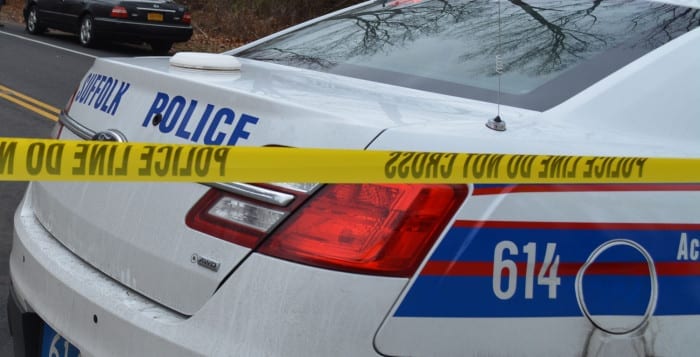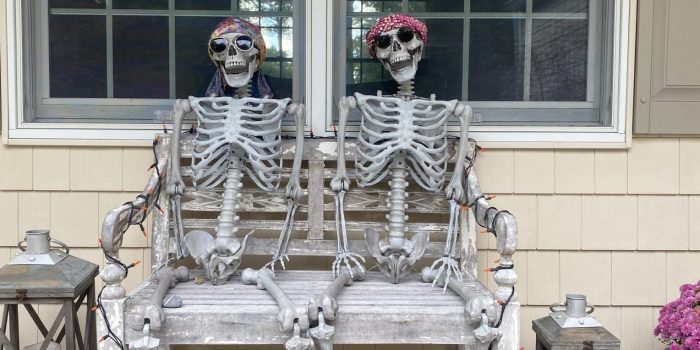Gurwin celebrates Disney’s 100th anniversary with jubilee
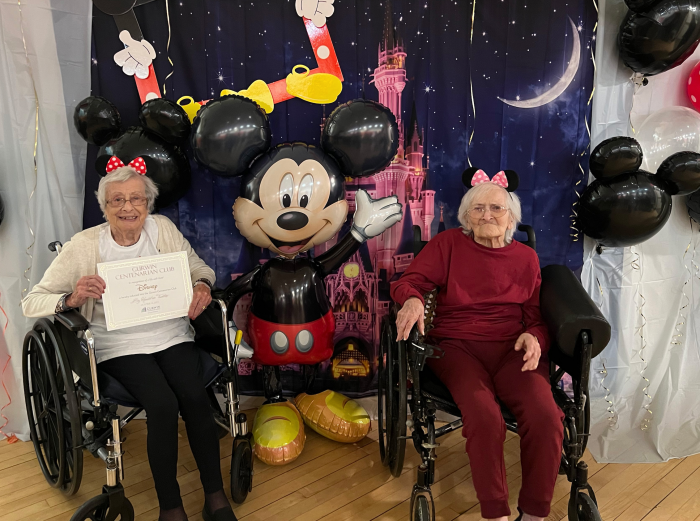
More than 300 residents and staff of Gurwin Jewish Nursing & Rehabilitation Center in Commack recently celebrated a century of Disney’s rich history of magic and storytelling with a 100-year jubilee commemorating both the milestone anniversary as well as Gurwin centenarians who inducted Disney into the “Gurwin Centenarian Club. ”
“We are so excited that our residents are able to celebrate Disney’s 100th birthday as if they were actually at Disney themselves,” said Nicole Hopper, CTRS, Director of Therapeutic Recreation at Gurwin Center. “Since our residents are unable to travel to Disney, we decided to bring the magic of Disney to them.”
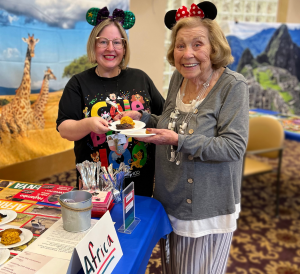
The essence of Magic Kingdom was experienced by all who stepped into the Center’s Simon Rainbow Room’s “100 Years of Wonder” event. Created by Gurwin staff dressed as Mouseketeers and other memorable Disney characters, the spectacular celebration was filled with Disney-themed memorabilia and activities, such as a Magic Kingdom photo booth, meet-and-greet characters and a caricature artist who sketched portraits of the residents and staff.
Gurwin residents enjoyed viewing Disney classics on the big screen, a learn-to-draw Mickey Mouse art station, and decadent Disney theme-park desserts such as churros, soft pretzels and the iconic Disney waffles. The celebration ended in true Disney fashion with the famous “Happily Ever After” firework show displayed on the big screen, much to the delight of residents, family members and staff.
The highlight: a ceremonial induction of Disney into Gurwin’s Centenarian Club. Residents Genevieve Fedele, 103, and soon-to-be 100-year-old Esther Halfon, presented an honorary certificate to Disney as the club’s newest member, offering sage words of advice: “Keep making magic!”
In addition to the celebration at the Gurwin Center, residents of Gurwin’s Assisted Living community, Fountaingate Gardens Independent Living Community and Island Nursing and Rehab Center in Holtsville, also a member of the Gurwin Healthcare System, participated in Epcot-themed celebrations and special Disney magic.
“Our staff across the System poured their hearts into creating enchanting events for all of our residents,” said Stuart B. Almer, President and CEO of Gurwin Healthcare System. “It was a wonderful day of nostalgic festivities, with the icing on the cake being our 100+ year-old residents welcoming Disney into the Gurwin Centenarians Club. We are so fortunate to have such a talented and caring team that creates such amazing experiences for our residents, their families and our staff members as well.”
D. None of the Above: As role models, parents can help create a better world for our children
By Daniel Dunaief

My wife and I used to say “the recording is always on.”
It was our code words to each other to be careful about what we said and did in front of our children, particularly when, as many parents know, we might not want our children to act or speak in the same way we might be tempted to in the moment.
Our children have an incredible ability to monitor everything we do, even when they don’t appear to be paying any attention to us. Sometimes, they actively choose the opposite because our choices annoyed or frustrated them.
If, as many of us say and believe, we want our children to be better than we are, we wish them well, wait and watch, hoping their happiness, success and achievements far exceed our own.
Perhaps such reaction formation is what brings grandparents and grandchildren together, causing various characteristics to skip a generation, as two opposites create the same.
Aside from things like weekly routines, an emphasis (or not) on achievements like community service, or performance in sports or music, parents recognize that we are role models.
In the movie “42” about trailblazer Jackie Robinson, the first African-American man to play in Major League Baseball, a father shouts racial epithets at Robinson, leading his conflicted son to ponder how to behave. The son echoes what his father shouts.
In that moment, Peewee Reese puts his arm around Robinson, offering his public support and quieting the hostile crowd. Reese even suggests, as a nod to the realities of today, that “Maybe tomorrow we’ll all wear number 42. That way they won’t tell us apart.”
Films are great, but we don’t live in a world where supportive music and smiling heroes remind us who we are or how we should act.
It’s up to us to decide how to be better for ourselves and for our children.
A friend recently shared a story about his daughter. A college student, she was working at an ice cream store during a fall break. A few customers came in and a man in the group asked her where she attended college.
When she told him, the man suggested that there were Muslims who attended that college and it would be easy enough to take a few of them behind the shed and get rid of them.
The man who made a joke about murder at a time of violent conflict in the Middle East and ongoing and hostile disagreements among Americans probably wasn’t thinking about his children, about my friend’s daughter, or anyone else.
Maybe he was repeating the words his father or mother said at the dinner table, after an evening of drinking or within minutes of leaving a house of worship.
Is that the person he wants to be? Is that what he would encourage his own children to believe, that people who practice other religions or have other beliefs are somehow such enemies that it’s okay to make such a comment?
We have to be better than that. Maybe the guy didn’t mean it, but even saying it suggests that he not only thought it, but that he also likely shared that idea in some context in front of his children.
Killing and hatred won’t end if we don’t hold ourselves accountable for our actions and words.
We identify ourselves in particular ways, by such factors as nationality, religion, race, among many other labels.
Those identifiers, many of which we didn’t choose but are an accident of our birth, mean that others around us are on the outside, associating with a different group.
We owe it to our children to imagine and create a better world. That starts by serving as role models and not as reflexive perpetuators of anger, hatred, or prejudice towards those we consider others.
With the world echoing the conditions from the 20th century, we should speak and act in ways that bring people together and that would make us proud if and when we heard our children making those same, or perhaps better, remarks.
Between You and Me: Election special from TBR News Media
By Leah S. Dunaief

Inside this issue is a treasure trove of first-hand information about the candidates and the issues in the coming election. How do I know? Because we, the different members of the editorial board of Times Beacon Record Newspapers, personally interviewed 25 people running for office across the three towns that we serve: Brookhaven, Smithtown and Huntington. The offices the candidates are running for are all local, which means that these are the officials who will have the most direct effect on our lives.
The positions range this year from county legislators to town supervisors, town council, and town clerk. We asked them questions without bias, seeking only to understand who they were, what they believed and what we could expect from each of them, should they be elected — or re-elected, as the case might be. The setting in our conference room was relaxed, and we hoped comfortable, with opponents for each office seated together around the table responding to questions put to them by our editors and reporters.
Sometimes there were four candidates, sometimes only one who might be running unopposed or against a shadow opponent, but mostly there were two during each session. Most of the time, the hour goes by calmly, but occasionally the opponents get testy with each other — they may even become openly hostile.
At one such session some years ago, one of the candidates invited the other out to the back parking lot “to settle things.” When the other began to take off his jacket, we quickly intervened. But there were no such flare-ups this year.
The answers were timed in an attempt to get to the main ideas without running on too long. There was ample time at the end for each visitor to tell us anything more that perhaps we hadn’t elicited with our questioning.
We have written up the details of each interview in a separate article for the election section. And we discuss the candidates at the end of each hour and come to a conclusion for the endorsement.
Most of the time, the editorial group was unanimous because the choices were fairly direct. But for a couple of races, we talked over the pros and cons of each candidate at length before making the selection. These endorsements are based on both the in-depth interviews and the considerable information we know about the incumbents since we have been covering them closely throughout their terms in office. Of course, after reading the stories, you may or may not agree with our conclusions. Our job is to get you thinking.
The many hours that are given to this task, throughout the month of October, are a service for our readers. We are privileged to enjoy an extended face-to-face time with those standing for election, and we feel an obligation to pass along whatever information, facts and impressions we gather during these sessions. We sincerely hope we help in the sometimes-difficult job of casting a responsible vote.
Each year we include in the election section a sample ballot that we are able to procure from the Suffolk County Board of Elections because readers have told us that it is a great advantage for them to receive the ballot at the voting poll already knowing how it is laid out.
Our editorial board is made up of staffers with different political leanings, but when we put our journalists’ hats on, we try to judge each race strictly on the merits of the opposing candidates. And while it is technically possible for me to be tyrannical about the final selections, that is almost never the case. We decide by majority rule.
Sincere thanks to the talented staff who join in this extra work each year. We truly believe that we are watchdogs for the people, and nowhere is that more necessary than in reporting about government and its office holders. We hope we have helped you, whether you read by newspaper and/or online. Now please vote.
Update: Human remains found at Sunken Meadow State Park

UPDATE: Yoneli Abimael Ramos Moreno, 20, of Brentwood, was identified as the man whose remains were found at Sunken Meadow State Park on Monday afternoon, New York State Police said in a press release on Nov. 1.
Ramos-Moreno was found by parkgoers off a trail at the eastern end of Sunken Meadow State Park, police said. His death is being investigated as a homicide, police said. He died recently, officials said.
Below is the original press release:
On October 30 just before 1 p.m. the New York State Police and New York State Park Police responded to a report of male human remains found at Sunken Meadow State Park in Kings Park.
The New York State Police Bureau of Criminal Investigation (BCI) and Forensic Identification Unit (FIU) responded to the scene to investigate.
The remains were taken to the Suffolk County Medical Examiner’s Office, where an autopsy will be conducted to determine the cause of death. The person’s identity was not immediately clear, nor was how long the remains were there, who found the remains, or if there was foul play.
This is an active investigation and the State Police is asking for any witnesses or anyone with information to call 631-756-3300.
SBU names Pierce Native American Studies director, plans new hires

Stony Brook University named Joseph Pierce, associate professor in the Department of Hispanic Languages and Literature, the inaugural director of a Native American and Indigenous Studies effort as the university plans to hire three new faculty in this nascent undertaking.
Next year, the southern flagship school of the State University of New York plans to add staff in the English Department, Women’s Gender and Sexuality Studies and Anthropology.
“I have been eager for this to start,” said Pierce, a member of the Cherokee Nation who has been at the university for a decade. “We have so much to contribute to broader discussions that are happening around the world. The university is better by including Native American studies.”
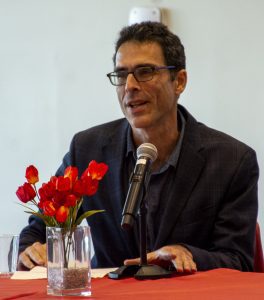
Andrew Newman, professor and current chair of the Department of English, who is also chair of a committee advising Axel Drees, interim dean of the College of Arts and Sciences, described Pierce as having a “real national profile,” adding that he was the “right person to be the founding director.”
Starting next fall, students at the university can minor in Native American and Indigenous Studies, where they can study the history, art, social and political interests, languages and cultures of Indigenous peoples.
The focus on Native American Studies will emphasize transdisciplinary topics such as environmental justice and sustainability.
Earlier this year, Stony Brook won a competition to develop Governors Island as a climate solutions center [See story, “SBU will develop $700M climate center on Governors Island,” April 26, TBR News Media].
Indigenous scholars should have a “seat at the table,” said Newman, “as they are globally one of the demographics most impacted by climate change.”
Islands in the Pacific are disappearing, Guam is undergoing “significant environmental degradation,” and fires in the Pacific Northwest and leaking pipelines in the United States and Canada are “disproportionately affecting Indigenous peoples,” Pierce added.
Indigenous groups relate to the land in a way that’s different from others, approaching it as stewards and caretakers, Pierce said.
“We see land as a relative,” he noted. “We’re asking very different questions about what it means to care for a place and to care for the environment and to care for the life that sustains it.”
The New York City government proposed plans for flood relief on the lower East Side of Manhattan in the event of future storms like Hurricane Sandy. The proposals included building massive walls and raising elevated platforms, including clearing thousands of trees.
Numerous indigenous groups objected and protested against such plans, Pierce said.
In an email, Carl Lejuez, Stony Brook University’s provost, suggested that a significant piece of Governors Island is climate justice, so the link between the Governors Island effort and indigenous peoples “fits naturally with the goals of the New York Climate Exchange.”

Lejuez credited Drees as a “driver of this in collaboration with Professor Pierce.” Lejuez added that his office is “definitely providing support to see it come to fruition.”
The most crucial component in the start of this effort is hiring faculty.
“If we build the core faculty across the university, we can definitely consider expanding research and curriculum opportunities,” Lejuez wrote.
Student interest
Students from the Anthropology Department recently invited Pierce to give a talk about some of his current research.
“It was evident that a lot of them have an interest in working toward understanding humanity, what it means to be human,” he said. They also have an understanding of how anthropology as a discipline has sometimes historically “adopted rather unscientific and proto-eugenic methods” in describing and analyzing Indigenous Peoples.
Students are eager for an alternative perspective on the acquisition and acceptance of knowledge.
Pierce believes students have considerable interest in Native American Studies. His courses about Latin American indigenous populations are full.
“There are numerous students who are interested in Native American and Indigenous studies but don’t quite have a cohesive plan of study that’s available to them,” Pierce said. “This is remedying that disconnection.”
Long Island students grow up in numerous towns and communities with Native American names, such as Sachem, Wyandanch, Montauk and Setauket.
Newman added that the staff hopes the new effort can do some “outreach to local schools and provide professional development with kindergarten through 12th-grade teachers. It would be an important mission for the university to educate Long Island as a whole about Native culture.”
Happy Halloween from TBR News Media
HAPPY HALLOWEEN!
From all of us here at TBR News Media, have a SPOOK-tacular day!
From Scottish rituals to pumpkin wonderlands: Long Island’s haunting Halloween evolution
By Nasrin Zahed
Halloween has a rich history on Long Island that dates back to the early colonial days. Over the centuries, it has evolved from ancient Scottish rituals to the modern-day extravaganza of costumes, candy and spooky spectacles.
Halloween’s origins can be traced back to the ancient Scottish festival of Eve of All Hallows, celebrated around the end of October. Though commonly believed to be derived from the Celtics, Henry Kelly, distinguished research professor in the Department of English at the University of California, Los Angeles, has provided the research to debunk such a claim.
“People in Ireland also indulged in similar festivities on the day before All Saints’ Day, including divination games and competitions like apple bobbing,” said Kelly in an email exchange.
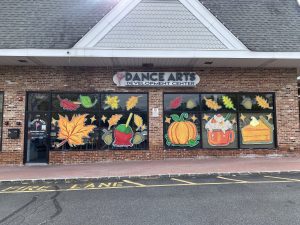
Halloween customs came to America primarily through the Irish immigrants in the 19th century. The practice of carving Jack-o’-lanterns, a staple of modern Halloween, is often attributed to Irish immigrants who brought the tradition of carving turnips with them. The orange pumpkin, native to North America, became the go-to canvas for spooky faces and designs.
Though of all the traditions to be brought over, dressing up on Halloween and going door to door is still a bit hazy. “The question of when children started masquerading and going around for treats at Halloween in America needs further research,” Kelly said.
Regardless, Halloween has adapted to become one of the most profitable holidays of the year. Seeing as the United States has a strong consumer culture, Halloween became an opportunity for retailers to tap into this market. Businesses saw the potential in selling costumes, decorations, candies and other Halloween-related products.
There is no question that Long Island has found a niche in that market as fall makes Long Island a scenic destination for all things fall fun.
With its agricultural history, Long Island is also home to numerous farms and pumpkin patches, where families can pick their own pumpkins and enjoy fall-themed activities. Others can enjoy an array of haunted attractions and houses that draw thrill seekers and horror enthusiasts during the Halloween season. Places like Darkside Haunted House in Wading River and Gateway’s Haunted Playhouse in Bellport offer terrifying experiences for those brave enough to enter.
Long Island boasts numerous historical sites with eerie legends and ghost stories.
One of the standout Halloween events is the Rise of the Jack O’Lanterns at Old Westbury Gardens, showcasing thousands of intricately carved pumpkins, transforming the gardens into a mesmerizing pumpkin wonderland. The event is being held through Nov. 2.
Local businesses and communities have embraced the spirit of Halloween, with businesses decorating their storefronts and residents adorning their homes with creative and spooky decorations.
Hailey Hamilton of Old Wood Road, Stony Brook, shared her thoughts on the upcoming holiday, saying, “Halloween in our town is always a blast. The decorations go up, the costumes come out, and the spirit of the season is infectious. It’s the perfect time of year to enjoy some spooky fun with friends and family.”
A fascinating tapestry of ancient Scottish customs, early American traditions and modern-day festivities, Halloween on Long Island is the one to beat. A bewitching experience for all ages, Long Islanders have embraced this holiday with open arms, making it an integral part of their culture.
If you find yourself on Long Island in late October, be prepared for a ghoulishly good time.
Hauppauge High School hosts French students for exchange program
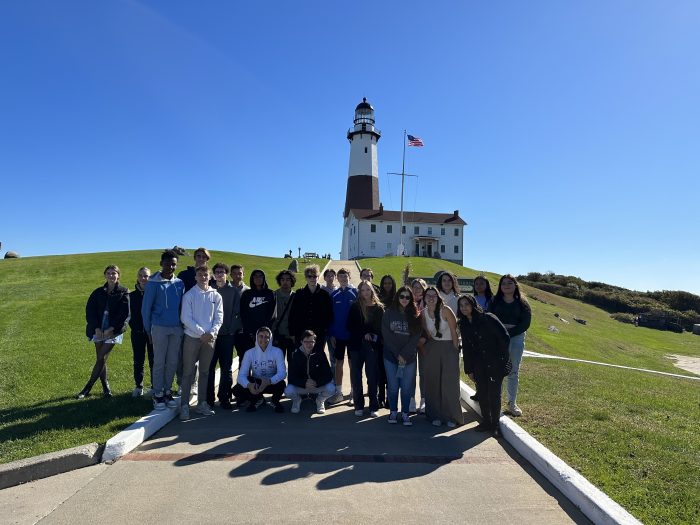
Several Hauppauge High School students in Christine Rigaud’s French class had the unique opportunity to participate in a once-in-a-lifetime exchange program. While a group of students from Angers, a city in the Loire Valley, France, visited Long Island, staying with Hauppauge students for 10 days, their Hauppauge counterparts will be going to Angers in November to stay with the French students and their families.
Arriving on Oct. 9, the French students met their American hosts at Hauppauge High School before going home with the local families for the first time. The following day, students were given a welcome breakfast and tour of the school where they followed their exchange partners, going from class to class and at after-school activities.
Throughout the week, the students were taught a lesson on Long Island geography and historical points before visiting Sagamore Hill National Historic Site, home to President Theodore Roosevelt, and Montauk Point Lighthouse.
The exchange students even experienced an American Homecoming football game Oct. 14. During their remaining days exploring Long Island, the exchange students spent time with their host families, doing local activities such as Topgolf, bowling and even trekking into Manhattan for a Broadway show.
Their trip culminated with a few days in Manhattan, visiting Times Square, Grand Central Station, the American Museum of Natural History, Chinatown, the Brooklyn Bridge, the Statue of Liberty, the 9/11 Memorial site, the Empire State Building and a tour of Columbia University.
On Nov. 4, Hauppauge High School students will visit the Lycée Mongazon school in Angers for the exchange. While there, they will attend classes, participate in a walking tour and scavenger hunt with their exchange partners and visit several castles and cultural sites. Then, they will head to Paris where they will visit the Louvre, Notre Dame, the Latin Quarter, Shakespeare and Company bookstore, Saint-Germain-des-Prés the Eiffel Tower, Les Champs-Elysées, L’Arc de Triomphe, travel the Seine River via boat cruise and more.
“When the students participate in an exchange program, the rewards are infinite,” Rigaud said. “Using the language in real-life situations, learning firsthand about the culture, traditions and food, speaking with the locals, visiting historic sights and learning about the history are just a few of the benefits.”
She added, “The students become more mature and self-confident as they navigate new situations. They learn to see things from a different perspective and become global citizens who are more understanding and accepting of cultural differences. Every time I travel with them, I get to see things through their eyes. It’s an amazing experience.”
Editorial: Informed voters, effective officials — Why local elections matter
While every election is important, we take special care in informing our readers ahead of local races. With Election Day — Nov. 7 — fast approaching, we remind our readers why voting in local town and county elections is critical.
Unfortunately, many Americans today are losing faith in our democratic norms. Everywhere we look, we see partisanship, tribalism and polarization undermining our political process. National media sources often feed into and inflame these divisions for monetary and partisan gain.
Lower levels of government can offer a powerful counterbalance to all of this noise. Both literally and figuratively, local officials are closer to the people — their seats of government are located within our communities, and their decisions more immediately influence our day-to-day lives.
The issues debated by local legislatures are often far removed from the political theater observed in Washington and Albany. Local elections are not about the national debt ceiling, universal free health care or American foreign policy — remote if important issues in our ordinary lives.
Local elections are about us and the complexion of our community. They determine land use and zoning policies within our neighborhoods and commercial districts, drainage and related wastewater infrastructure investments, waste management services, park access, street paving and much more. Local elections determine the granular matters which shape our relationships to our surrounding area.
We remind our readers to be especially wary of candidates and commentators who inject national issues into our local dialogue. Those who do so are often ideologically driven, engaged in illicit political posturing.
We advise prospective voters to begin researching their ballots thoroughly. A functional local democracy requires a well-informed, enlightened electorate. And the more informed we are collectively, the better our elected officeholders will be.
When considering a candidate for local office, we should never decide based on party affiliation alone. This one-dimensional voting strategy cheapens our votes, outsourcing our decisions to the party bosses who handpick the nominees on our ballots.
We must ask ourselves whether a candidate possesses the requisite professional experience and knowledge to advance our interests. We must ask whether their values align with our own. And we must determine whether a candidate is running to promote the public good or to serve their self-interest.
Next week, TBR News Media will release its annual election supplement. Through interviews with various local candidates across our coverage area, we hope our readers will enter the voting booth better equipped to make informed judgments. We will also offer endorsements for candidates who best reflect our staff’s values.
With less than two weeks to go, we must get serious about our votes — because local elections matter.





